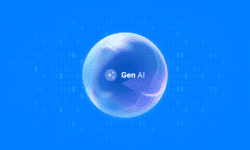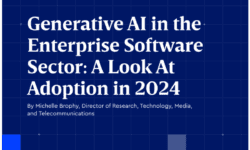Generative artificial intelligence (genAI)—it’s seemingly ubiquitous, from its ascending market evaluation (reaching a $1.3 trillion by 2032 according to Bloomberg), to its proposed applications in nearly every industry (i.e., consulting, manufacturing, financial services, etc.) to its potential limitations. And while these discussions have been integral to understanding the importance of this iteration of AI today and in the years to come, the question of its value on an individual basis, and specifically within marketing intelligence, is left unanswered.
In our State of Generative AI & Market Intelligence Report 2023, we found that genAI has already surpassed other types of AI tools in market intelligence research, with two-thirds of our survey respondents indicating they have already used ChatGPT-style tools for market intelligence purposes.

Without the tangible facts and numbers every C-level executive requires for implementing genAI into their operations, you’ll likely fall behind in the race for adoption—and worse, miss out on the ROI your competitors experience. But some industry leaders are still unsure of how this technology can help them, their team, and operations—in other words, what is the ROI of genAI in market intelligence? Below, we dive into the ROI C-level executives are realizing from genAI and how it’s affecting everything from their productivity to profits.
Peaking Productivity and Time-Savings
It’s inevitable that genAI will become commonplace within business operations across industries. According to Accenture, it’s predicted that up to 40% of working hours will be assisted or enhanced by language-based AI. Additionally, 98% of business leaders surveyed believe that AI foundation models will be crucial to their organizations’ strategies in the next three to five years. Why, exactly? The primary advantages of employing genAI are significant time savings and the reduction of monotonous tasks.
“Generative AI has the potential to change the anatomy of work, augmenting the capabilities of individual workers by automating some of their individual activities,” McKinsey states. In other words, today’s iteration of AI and other technologies can automate tasks that currently consume 60-70% of employees’ time—a significant increase from McKinsey’s earlier estimate of 50%.
The rapid adoption in automation is primarily attributed to the enhanced natural language understanding capabilities of generative AI, otherwise known as natural language processing (NLP) models, which are crucial for tasks occupying 25% of total work time. Consequently, generative AI has a more pronounced effect on knowledge work in professions with higher wages and educational prerequisites, compared to other forms of work.
In our State of Generative AI & Market Intelligence Report, survey respondents said time savings and reducing tedious work were the biggest benefits of using AI in business—80% of respondents said “time-savings” associated with using genAI tools was the major benefit while “eliminating tedious work” came in close second at 75%, followed by “automated insights” at 54%.
Further, respondents said time savings and reducing tedious work were the biggest benefits of using AI in business—80% of respondents said “time-savings” associated with using genAI tools was the major benefit while “eliminating tedious work” came in close second at 75%, followed by “automated insights” at 54%.
Reorganized Workforce Efforts and Cost Savings
What does AI in market intelligence mean for knowledge workers, exactly? It helps to game out possible consequences of business strategies and actions, effectively streamlining the decision-making process and allowing workers to prioritize analyses of these outcomes rather than waste time aggregating data.
From an operational perspective, leadership will see their workers spending more time on valuable work (that cannot be accomplished by AI nor automation) and less on menial, tedious tasks—optimizing efficiency and productivity within their workforce.
Ultimately, implementing genAI technologies has streamlined mundane, repetitive, and even costly tasks while optimizing process results, allowing human workers to focus on more analytical work. For example, knowledge workers commonly spend upwards of $15,000 to $35,000 for a market intelligence report, relying on a variety of techniques (interviews, surveys, focus groups, etc.) to learn what people want and need, and why they do. Not only is market research expensive, but time-consuming—taking weeks, if not months, to conduct.
In some instances, efficiency gains brought on by genAI tools can lead to a reduced need for employees to accomplish the same workload, resulting in cost savings (e.g., fewer data entry operators needed as forms are digitized). However, this outcome is not guaranteed. While some organizations simply translate saved hours into hiring fewer people, hoping to cut labor costs, this approach may not always succeed—when you trim the time an employee spends on a task by 20%, they could fill that time with meaningful work genAI could not complete.
And it’s not a question of if your competitors will restrategize how business is done, but when. According to LinkedIn, organizations that plan to invest more than $50 million in AI and genAI next year are 1.3 times as likely as their peers to see cost savings in 2024—and 1.5 times as likely to save more than 10% in costs.
These numbers are supported by a survey recently conducted by KPMG LLP, which found that 72% of respondents (a pool of 225 U.S. executives) said that generative AI could play an important role in increasing productivity, and 66% said that the implementation of genAI would require both hiring new talent, as well as training existing talent. Ultimately, genAI tools within the market intelligence industry do not serve to replace human capital, but rather reprioritize and realign its value within an organization.
Efficient Onboarding and Reduced Knowledge Turnover
Within an organization, two elements are crucial to maintain optimal productivity—onboarding and knowledge retention. Without the ability to quickly educate your team on how to do their jobs most efficiently and, more importantly, compile employee insights into a centralized source, C-suite leaders are left wasting countless dollars and hours on their operations. “In 2023, small companies spent the largest amount of time on training per employee, totaling roughly 59 hours while larger companies in the United States increased their investment in staff training between 2017 and 2020,” Statista reports.
One of genAI’s many capabilities is retrieving valuable internal information across an organization and summarizing it so that personnel, new and seasoned, spend less time searching for answers to important questions (e.g. what slide decks did we use for a large-cap tech client presentation?). Likewise, managers spend less time training because, with an internal knowledge base leveraging genAI, information is easily discoverable. However, what happens when institutional knowledge or IP becomes lost when an employee leaves an organization? Especially in the case of an abrupt departure, a familiar scenario unfolds: the work a former employee has done is buried in folders and storage platforms, and only they know how to easily locate it.
According to a new report from Code42, this is a reality many leaders have faced. There’s a one in three (37%) chance a company loses IP when an employee quits, leading to chances of sensitive data leaving an organization. Additionally, 71% of cybersecurity leaders and practitioners report not knowing what and how much sensitive data departing employees are taking to new organizations.
Though 96% of companies note they’re experiencing challenges protecting corporate data from insider risk, ownership of the problem is murky. GenAI can streamline the process of storing and finding important information, so that it isn’t lost with the person who created it. Ultimately, extending the value of your IP requires using genAI that can surface it when you need it, regardless of who owns it.
Eliminating Information Silos
Among organizations, a common industry need is omnipresent: to render internal research as discoverable and manageable as the external content being published in public marketplaces. And while the use cases for genAI seem endless and invaluable, C-Suite execs have taken particular note of the technology’s ability to eliminate internal content silos and improve the discoverability of internal research and documents.
The solution lies in leveraging genAI’s machine learning algorithms. By comprehensively and thoroughly understanding not only the content of each document but the context of each paragraph, sentence, and word used, genAI can begin to make sense of data in ways that were never possible before.
By understanding the context and semantics of queries, genAI refines search algorithms, delivering more relevant and precise results so that crucial internal documents are more easily found—and countless hours are not spent resharing information that already exists. This technology goes beyond keyword matching by considering the intent behind each search. Employees can now access critical information swiftly, boosting productivity and reducing the burden on IT support.
From the C-Suite: the Value of GenAI in Business
“And while we’re still in the very early stages of generative AI, we’re already seeing tangible AI-driven improvements in productivity and cost savings. Measurable progress has been made with lowering customer support costs, unlocking software development efficiencies and improving our network design effectiveness. We expect these capabilities to play a key role in our continued efforts to achieve our future cost savings objectives.”
– AT&T Inc. | Q3 2023 Earnings Call
“Be aware that more than 1,000 of our developers already generate more than 10% productivity gains as we speak based on GenAI deployment.”
– Worldline SA | 2023 Earnings Call
“The emersion of generative AI will transform the way we engage in the workforce, as it creates efficiencies and time savings for companies with daily tasks such as drafting emails, documenting notes and sourcing data insights.”
– Crayon Group Holding ASA | Q4 2023 Earnings Call
“That BCG report found that only 6% of companies have managed to train more than 25% of their people on generative AI tools so far. 46% of their workforce on average, will need to undergo upskilling in the next 3 years due to generative AI. And nearly half of the leaders say that they don’t yet have guidance or restrictions on AI and generative AI usage at work. As every facet of our society grapples with the need to improve their productivity, agility, and human capital in this new world of generative AI, we believe that they will require education and training to do this quickly, but safely.”
– Coursera, Inc. | Q4 2023 Earnings Call
“In addition, we anticipate a 15-20% increase in engineering productivity in 2024 driven by the use of generative AI at multiple points in the software development and release process. These efficiencies, along with our expected revenue growth and strong financial profile, give us the ability to reinvest back into the business in sales and engineering for market share gains while simultaneously expanding our share repurchase program.”
– Coursera, Inc. | Q4 2023 Earnings Call
“Enterprise software companies are applying generative AI to help customers realize productivity gains. All the customers we’ve partnered with for both training and inference of generative AI are already seeing notable commercial success.”
– NVIDIA Corporation | Q4 2024 Earnings Call
Get in the Race for GenAI in Market Intelligence
In today’s highly competitive business landscape, marked by increased economic uncertainty and disruption across industries, a firm’s market intelligence resources hold greater value than ever before. They play a pivotal role in safeguarding competitive advantages and ensuring not just survival, but prosperity.
Ultimately, it’s not a matter of if you should have a market intelligence tool at your disposal, but rather, deciding on one you trust to keep you on the cutting edge of industry news and competitor developments.
That’s why top corporations, financial firms, and consultancies use AlphaSense as their go-to market intelligence platform. AlphaSense delivers first-in-class intelligence by integrating and leveraging proprietary industry-leading AI and genAI capabilities to help you extract crucial insights from both your internal content and the premium external content housed in our platform.
Discover the power of AlphaSense to increase the ROI of your market intelligence. Start your free trial today.
Check out this case study to learn how ODDO BHF, one of the largest private banks in Germany, used AlphaSense and its genAI capabilities to streamline insights and get the competitive edge.






